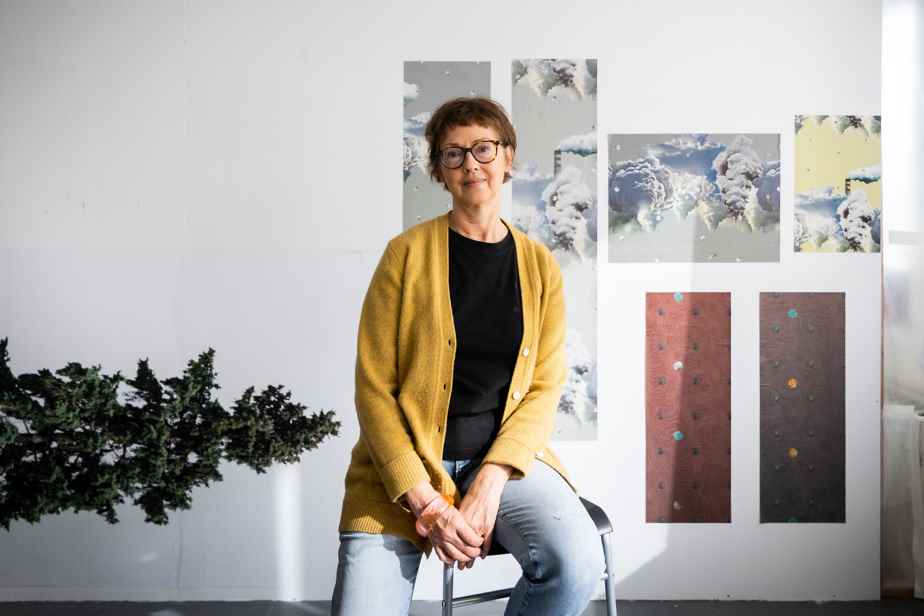Connected by public and experiential art, Diane Gougeon has had an original career for 30 years. Without openly criticizing the art market, she has detached herself from it, opting for a practice of installations that give meaning to the issues of our time, but which are difficult to sell! We met her in her studio in Côte-des-Neiges.
Posted at 4:00 p.m.
Artistic way
“It’s not that I don’t want to sell,” says the graduate of the University of Quebec in Montreal (UQAM) and Concordia. But my first choice has always been to go for works that make people react. For me, artistic objects are incomplete. Hence my interest in installations, so that the viewer can interact. »
Interested in the relationship of human beings with their environment, Diane Gougeon — who taught at Cégep Édouard-Montpetit and Collège Jean-de-Brébeuf — creates works to the rhythm of her desire to evoke the issues she sees. , such as the impact of technology in our lives.

PHOTO DIANE GOUGEON, PROVIDED BY THE ARTIST
half words1997-1998, X-shaped light box installed on the roof of Mr. Sully’s taxi
A student of the photographer Irene Whittome, she also dabbled in sculpture, collaborated with Articule and Optica, and exhibited at Samuel Lallouz, Circa and Joyce Yahouda. She has made poetic interventions in urban settings, such as half words, in 1997-1998, with luminous inscriptions in French on taxis to highlight the richness of French vocabulary. “I would actually prefer Montreal to be a French city rather than a bilingual city,” she says. Even if my spouse is English-speaking and I speak English! We must protect our heritage. » Language, environment, memory. Themes that have traced his artistic path, paved with good intentions.
Wallpapers
-

PHOTO SARAH MONGEAU-BIRKETT, THE PRESS
Plankton wallpaper at the Cultural Space of the Longueuil campus of the Université de Sherbrooke
-

PHOTO SARAH MONGEAU-BIRKETT, THE PRESS
Plankton wallpaper at the Cultural Space of the Longueuil campus of the Université de Sherbrooke
-

PHOTO PROVIDED BY THE ARTIST
Plankton seen up close, at the Espace culturel of the Longueuil campus of the Université de Sherbrooke
-

PHOTO PROVIDED BY THE ARTIST
Wallpaper pattern on display at Factory C, featuring small drones for cloud seeding
-

PHOTO PROVIDED BY THE ARTIST
Bee and flower motif, at the University of Sherbrooke. In the background, chemical drawings of neonicotinoid pesticides that do so much damage to animal species.
1/5
Diane Gougeon is in the middle of her project The wallpapers of tomorrow, an installation of large prints plastered on the walls of seven cultural and educational venues. With motifs evoking nature in the context of climate change. Each place has its motive and its subject of reflection. Clouds are the theme at Usine C. Le plancton, at the Espace culturel of the Longueuil campus of the Université de Sherbrooke. Bees, at the University of Sherbrooke. Mining, at the Cinéma du Parc, and the threatened boreal forest, at the National School of Public Administration.
Starting November 22, heat will be the subject discussed at Cégep Édouard-Montpetit and icebergs at the École nationale d’aérotechnique. Apart from its aesthetic aspect, the work is interactive thanks to printed augmented reality markers that allow access to sounds. Like the sound of a drone suggesting the buzzing of a bee. “Drones are already doing pollination,” says Diane Gougeon. It’s shocking. We destroy natural resources and replace them with mechanical bees…”
Workshop

PHOTO SARAH MONGEAU-BIRKETT, THE PRESS
Diane Gougeon in her studio
After having had a workshop in the city center, Diane Gougeon found, 10 years ago, a large premises in the Côte-des-Neiges district. “It hasn’t changed in price since then,” she said. Five and a half dollars a square foot! I would like there to be other artists in the building, because they are mostly churches! »

PHOTO SARAH MONGEAU-BIRKETT, THE PRESS
The carpentry area of the workshop
Diane Gougeon has separated her studio in two, with a removable partition: a carpentry part and another where there are several works from the past and tests of the Tomorrow’s Wallpapers. Also, photographs of pruned trees and two backlit boxes, with an image of snow settling in a municipal depot and dirty snow taken up close and giving the impression of a lunar landscape.
His projects
Diane Gougeon has been working for a long time on trees mutilated by human intervention, in particular to protect… electric wires. For two years, after being affected by The Overstoryby Richard Powers, on the unknown forces of nature, she is interested in the primitive forests of Quebec.

PHOTO SARAH MONGEAU-BIRKETT, THE PRESS
Two works by Diane Gougeon
“I made contacts at the Ministry of Forests and went to see the trees in an ancient forest,” she says. Some forests date from the beginning of the colony, preserved because they are difficult to access. Maybe I will make a corpus with large format holographic photography. The artist wants to carry out this project in collaboration with local communities, including aboriginals. “Because I want my project to make sense,” she says.
Some works
-

PHOTO PROVIDED BY THE ARTIST
The (H/stories) we tell ourselves : at Circa in 2003
-

PHOTO PROVIDED BY THE ARTIST
Circular, in 2005. Octopus stickers, magnetic and reflective, applied to delivery vehicles and taxis. A corpus on the consumer society.
-

PHOTO PROVIDED BY THE ARTIST
Icing, 2008. Refrigeration device, white flocked pattern, ultraviolet lighting, electromagnetic pellet display, white styrene basin. With soundtrack.
-

PHOTO PROVIDED BY THE ARTIST
RAM, 2013, Underground Art, Stock Exchange Tower. Fourteen words and groups of words made in neon tube of three colors.
-

PHOTO PROVIDED BY THE ARTIST
Reach out and touch someoneexhibited at Samuel Lallouz in 1995
1/5

